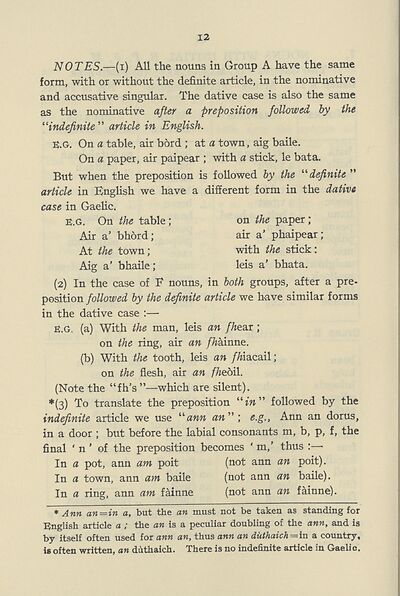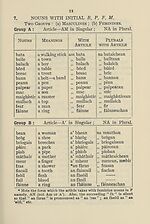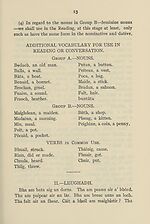Download files
Complete book:
Individual page:
Thumbnail gallery: Grid view | List view

12
NOTES.—(i) All the nouns in Group A have the same
form, with or without the definite article, in the nominative
and accusative singular. The dative case is also the same
as the nominative after a preposition followed by the
“indefinite ” article in English.
E.G. On a table, air bord ; at a town, aig baile.
On a paper, air paipear ; with a stick, le bata.
But when the preposition is followed by the “definite ”
article in English we have a different form in the dative
case in Gaelic.
E.G. On the table ;
Air a’ bhord;
At the town;
Aig a’ bhaile;
on the paper ;
air a’ phaipear;
with the stick:
leis a’ bhata.
(2) In the case of E nouns, in both groups, after a pre¬
position followed by the definite article we have similar forms
in the dative case :—
E.G. (a) With the man, leis an fhea.r ;
on the ring, air an fhkinne.
(b) With the tooth, leis an fhia.ca.il',
on the flesh, air an fhcbil.
(Note the “fh’s”—which are silent).
*(3) To translate the preposition “in'n followed by the
indefinite article we use “ann an” ; e.g., Ann an dorus,
in a door ; but before the labial consonants m, b, p, f, the
final ‘ n ’ of the preposition becomes ‘ m,' thus :—
In a pot, ann am poit (not ann an poit).
In a town, ann am baile (not ann an baile).
In a ring, ann am fainne (not ann an fainne).
* Ann an=in a, but the an must not be taken as standing for
English article a ; the an is a peculiar doubling of the ann, and is
by itself often used for ann an, thus ann an diithaich—in a country,
is often written, an duthaich. There is no indefinite article in Gaelic.
NOTES.—(i) All the nouns in Group A have the same
form, with or without the definite article, in the nominative
and accusative singular. The dative case is also the same
as the nominative after a preposition followed by the
“indefinite ” article in English.
E.G. On a table, air bord ; at a town, aig baile.
On a paper, air paipear ; with a stick, le bata.
But when the preposition is followed by the “definite ”
article in English we have a different form in the dative
case in Gaelic.
E.G. On the table ;
Air a’ bhord;
At the town;
Aig a’ bhaile;
on the paper ;
air a’ phaipear;
with the stick:
leis a’ bhata.
(2) In the case of E nouns, in both groups, after a pre¬
position followed by the definite article we have similar forms
in the dative case :—
E.G. (a) With the man, leis an fhea.r ;
on the ring, air an fhkinne.
(b) With the tooth, leis an fhia.ca.il',
on the flesh, air an fhcbil.
(Note the “fh’s”—which are silent).
*(3) To translate the preposition “in'n followed by the
indefinite article we use “ann an” ; e.g., Ann an dorus,
in a door ; but before the labial consonants m, b, p, f, the
final ‘ n ’ of the preposition becomes ‘ m,' thus :—
In a pot, ann am poit (not ann an poit).
In a town, ann am baile (not ann an baile).
In a ring, ann am fainne (not ann an fainne).
* Ann an=in a, but the an must not be taken as standing for
English article a ; the an is a peculiar doubling of the ann, and is
by itself often used for ann an, thus ann an diithaich—in a country,
is often written, an duthaich. There is no indefinite article in Gaelic.
Set display mode to:
![]() Universal Viewer |
Universal Viewer | ![]() Mirador |
Large image | Transcription
Mirador |
Large image | Transcription
| An Comunn Gàidhealach > An Comunn Gàidhealach Publications > Elementary course of Gaelic > (24) |
|---|
| Permanent URL | https://digital.nls.uk/196027043 |
|---|
| Description | This contains items published by An Comunn, which are not specifically Mòd-related. It includes journals, annual reports and corporate documents, policy statements, educational resources and published plays and literature. It is arranged alphabetically by title. |
|---|
| Description | A collection of over 400 items published by An Comunn Gàidhealach, the organisation which promotes Gaelic language and culture and organises the Royal National Mòd. Dating from 1891 up to the present day, the collection includes journals and newspapers, annual reports, educational materials, national Mòd programmes, published Mòd literature and music. |
|---|---|
| Additional NLS resources: |
|

